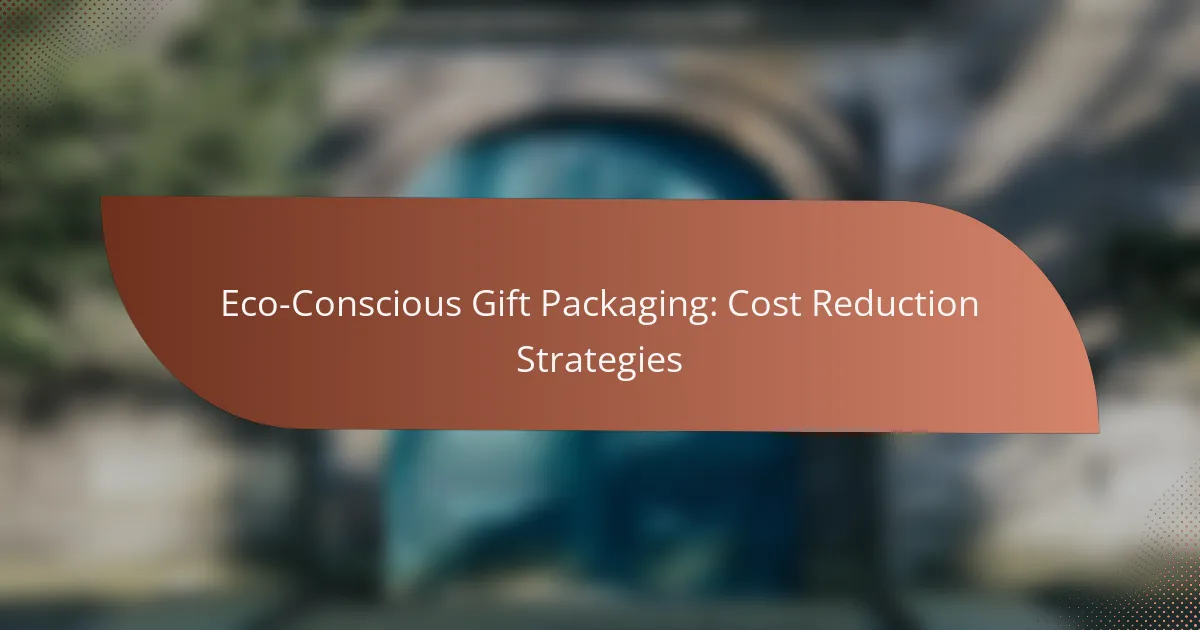Eco-conscious gift packaging presents a unique opportunity for businesses to reduce costs while appealing to environmentally aware consumers. By utilizing sustainable materials such as recycled paper and plant-based plastics, companies can minimize waste and enhance efficiency. Embracing these practices not only lowers packaging expenses but also contributes to a positive environmental impact.
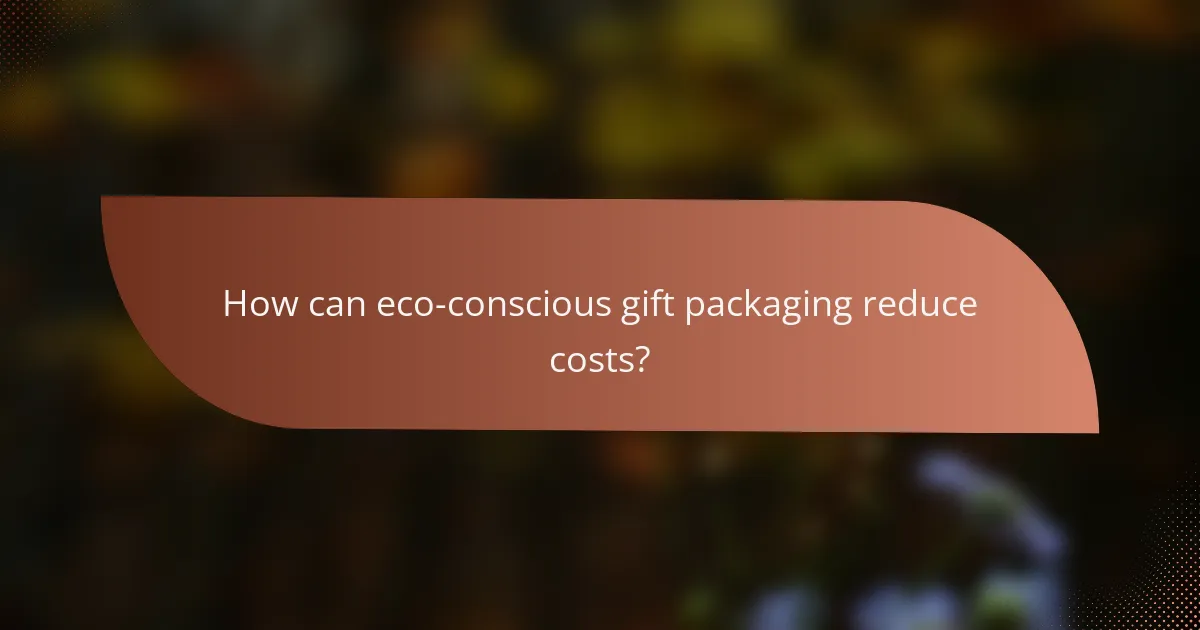
How can eco-conscious gift packaging reduce costs?
Eco-conscious gift packaging can significantly reduce costs by minimizing waste and utilizing sustainable materials. By adopting environmentally friendly practices, businesses can lower their overall packaging expenses while appealing to a growing market of eco-aware consumers.
Utilizing biodegradable materials
Biodegradable materials break down naturally, reducing landfill waste and often costing less than traditional packaging options. Common choices include plant-based plastics, recycled paper, and compostable fillers. These materials not only lower disposal costs but can also enhance brand image among environmentally conscious customers.
When selecting biodegradable options, consider their durability and suitability for your products. For instance, using recycled paper for gift wrap can be both cost-effective and appealing, while ensuring that it meets the necessary strength requirements for protection during shipping.
Implementing bulk purchasing strategies
Buying packaging materials in bulk can lead to significant cost savings. Many suppliers offer discounts for larger orders, which can reduce the per-unit price of eco-friendly packaging. This strategy not only lowers costs but also minimizes shipping frequency, further reducing carbon footprints.
To maximize savings, analyze your packaging needs and forecast demand accurately. Establish relationships with suppliers to negotiate better rates and explore options for shared shipping with other businesses to cut costs even further.
Leveraging local suppliers
Working with local suppliers can decrease shipping costs and lead times, making your packaging more efficient and sustainable. Local sourcing reduces transportation emissions and supports the community, which can resonate well with customers who value local businesses.
When choosing local suppliers, assess their sustainability practices and product offerings. Collaborate with them to create customized packaging solutions that align with your eco-conscious goals, ensuring that you maintain quality while keeping costs manageable.
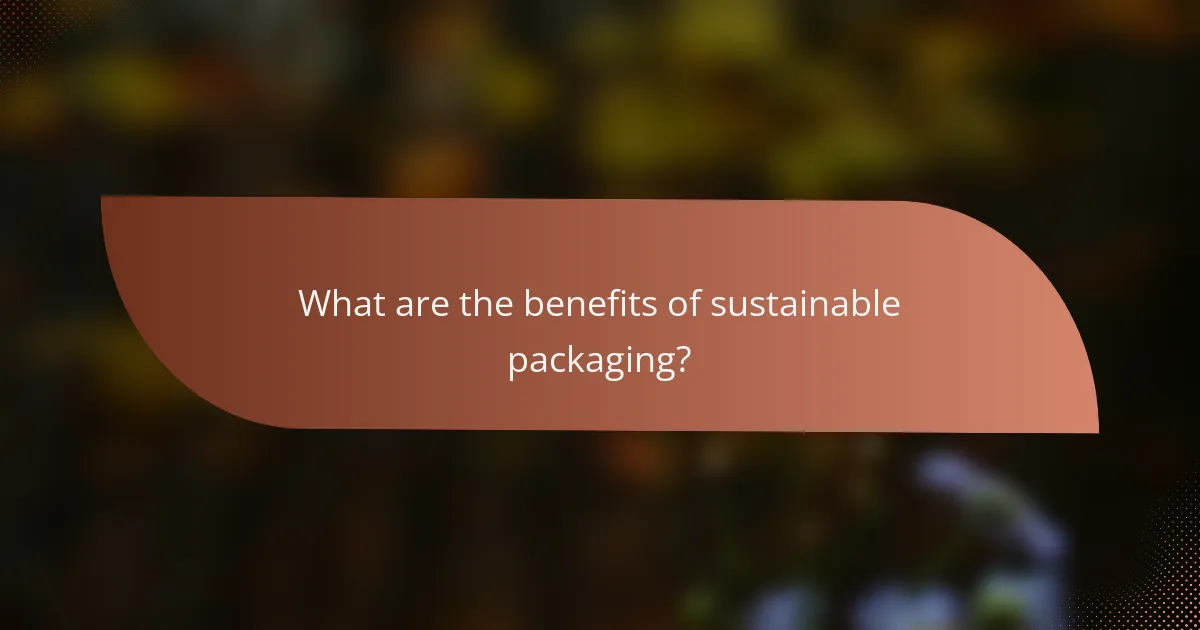
What are the benefits of sustainable packaging?
Sustainable packaging offers numerous advantages, including reduced environmental impact and cost savings over time. By utilizing eco-friendly materials and practices, businesses can enhance their overall efficiency while appealing to a growing base of environmentally conscious consumers.
Enhanced brand reputation
Implementing sustainable packaging can significantly enhance a brand’s reputation. Consumers increasingly prefer brands that demonstrate a commitment to environmental responsibility, which can lead to positive public perception and increased visibility.
For example, companies that use biodegradable materials or recycled content often receive recognition and accolades, further solidifying their standing in the market. This reputation can translate into competitive advantages, attracting new customers and retaining existing ones.
Increased customer loyalty
Customers are more likely to remain loyal to brands that prioritize sustainability. When consumers feel that their values align with a company’s practices, they are often willing to pay a premium for products that are packaged responsibly.
Offering incentives, such as discounts for returning packaging or loyalty points for eco-friendly purchases, can further strengthen this loyalty. Engaging customers through transparent communication about sustainable efforts can foster a deeper connection and trust.
Compliance with regulations
Many regions are implementing stricter regulations regarding packaging waste and sustainability. Adopting eco-conscious packaging not only helps businesses comply with these regulations but also positions them as leaders in environmental stewardship.
For instance, the European Union has set ambitious targets for reducing plastic waste, prompting companies to shift towards sustainable alternatives. Staying ahead of regulatory changes can mitigate risks and avoid potential fines, making compliance a practical benefit of sustainable packaging.
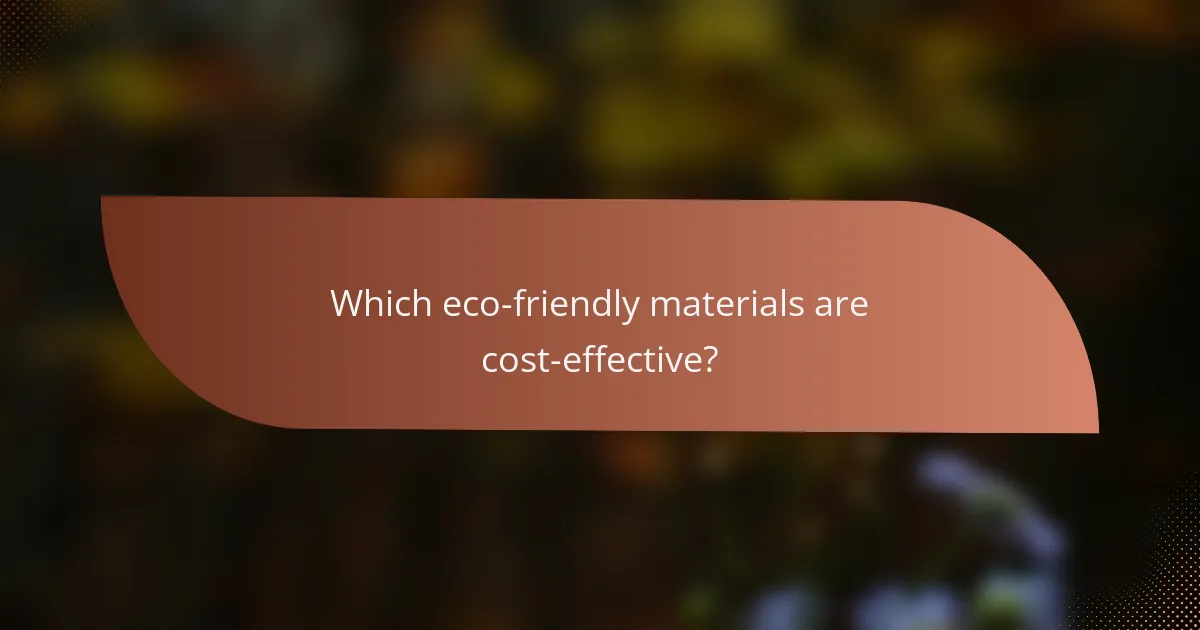
Which eco-friendly materials are cost-effective?
Cost-effective eco-friendly materials for gift packaging include recycled paper products, plant-based plastics, and reusable packaging options. These materials not only reduce environmental impact but can also lower overall packaging costs.
Recycled paper products
Recycled paper products, such as kraft paper and cardboard, are often less expensive than virgin materials. They are made from post-consumer waste, which helps reduce landfill contributions and resource consumption.
When choosing recycled paper, consider the weight and thickness to ensure durability. Many suppliers offer a range of options, typically priced between 10-30% lower than their non-recycled counterparts.
Plant-based plastics
Plant-based plastics, derived from renewable resources like corn or sugarcane, can be a cost-effective alternative to traditional petroleum-based plastics. These materials are biodegradable and can often be sourced at competitive prices.
While the initial cost may be similar to conventional plastics, the long-term savings from reduced waste disposal and potential regulatory incentives can make plant-based options more appealing. Look for certifications that indicate compostability to ensure environmental compliance.
Reusable packaging options
Reusable packaging options, such as cloth bags or sturdy boxes, can significantly reduce costs over time. By investing in durable materials, businesses can minimize the need for single-use packaging, leading to lower overall expenses.
Consider implementing a return program for reusable packaging to encourage customer participation. This approach not only fosters brand loyalty but can also reduce packaging waste and costs by up to 50% in the long run.
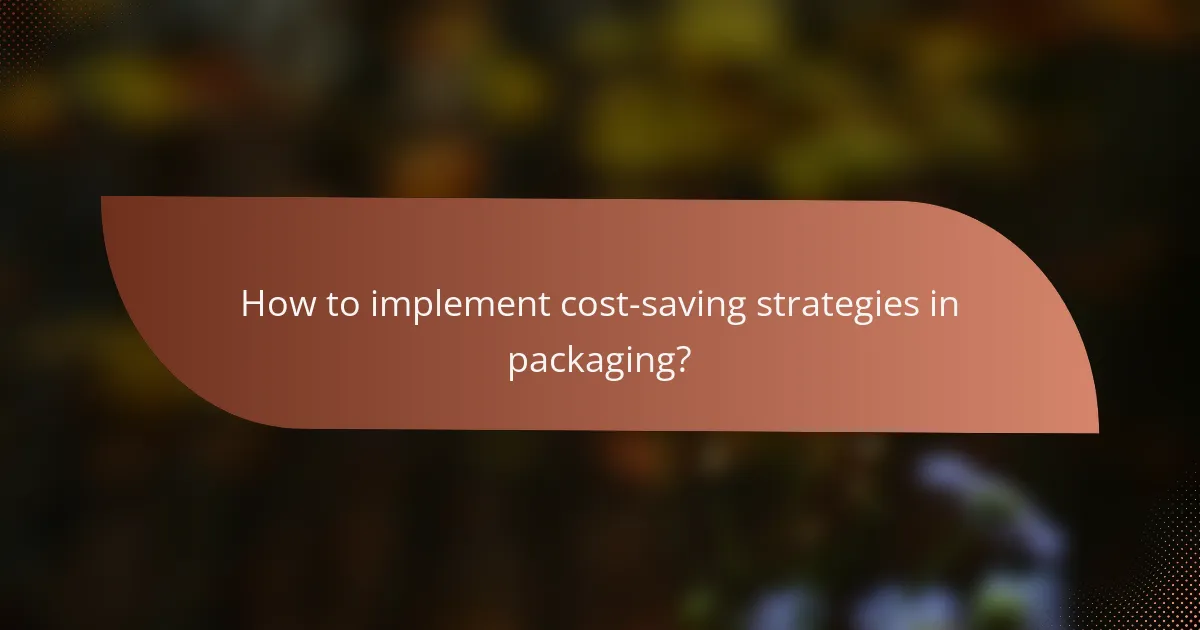
How to implement cost-saving strategies in packaging?
Implementing cost-saving strategies in packaging involves assessing current practices, redesigning packaging for efficiency, and training staff on sustainable methods. These steps can significantly reduce material costs while promoting eco-friendly practices.
Conducting a packaging audit
A packaging audit involves reviewing all aspects of your current packaging processes to identify inefficiencies and areas for cost reduction. Start by analyzing materials used, packaging sizes, and shipping methods to pinpoint wasteful practices.
Consider tracking metrics such as material costs, shipping expenses, and customer feedback on packaging. This data will help you understand where adjustments can lead to savings and improved sustainability.
Optimizing package design
Optimizing package design focuses on creating packaging that uses fewer materials without compromising product safety. Aim for designs that are lightweight and compact, which can lower shipping costs and reduce environmental impact.
Utilize design software to simulate packaging options and assess their efficiency. For example, consider using biodegradable materials or recyclable options that may cost slightly more upfront but save money in waste disposal over time.
Training staff on sustainable practices
Training staff on sustainable practices ensures that everyone involved in the packaging process understands the importance of eco-conscious methods. Provide workshops that cover efficient packing techniques, material handling, and recycling protocols.
Encourage employees to share ideas for reducing waste and improving packaging efficiency. Regularly revisiting training can help maintain a culture of sustainability and innovation within the organization.
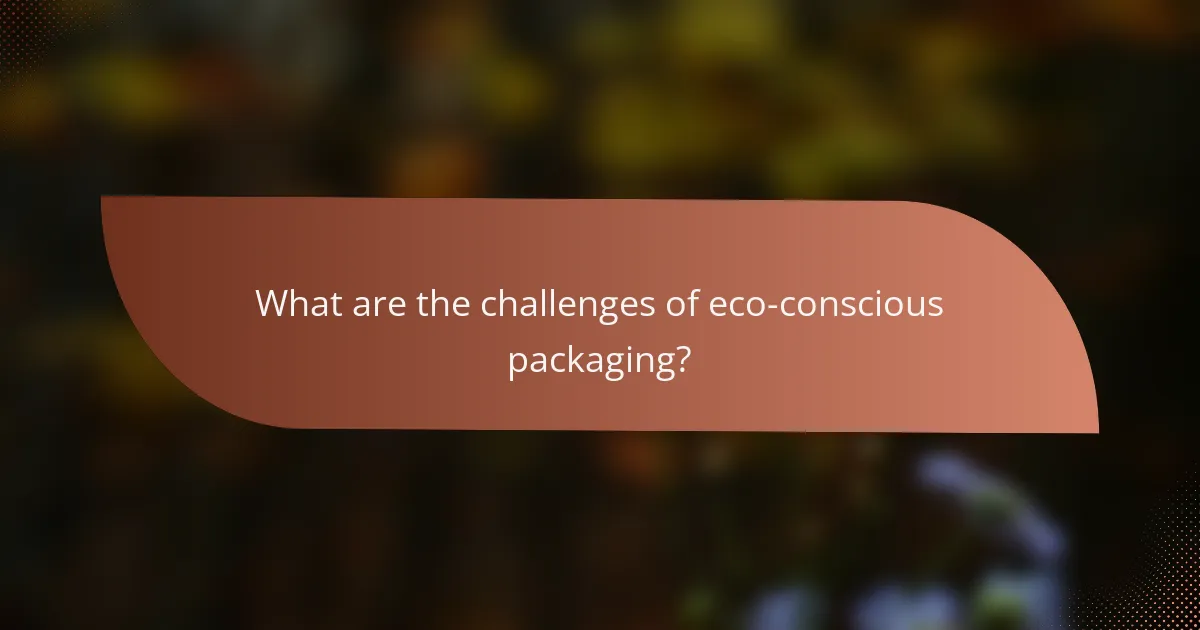
What are the challenges of eco-conscious packaging?
Eco-conscious packaging presents several challenges, including higher costs, supply chain issues, and consumer misunderstandings. These factors can complicate the transition to sustainable materials and practices.
Higher initial investment
Switching to eco-friendly packaging often requires a higher initial investment compared to traditional materials. Sustainable options like biodegradable plastics or recycled paper can be more expensive, which may deter businesses from making the change.
For example, companies might face costs that are 20-50% higher for eco-friendly packaging solutions. However, these costs can be offset over time through brand loyalty and reduced waste disposal fees.
Supply chain limitations
Eco-conscious packaging can be hindered by supply chain limitations, including availability and sourcing of sustainable materials. Many suppliers may not offer eco-friendly options, leading to longer lead times and potential delays.
Businesses should consider establishing relationships with multiple suppliers who specialize in sustainable materials to mitigate these risks. Additionally, investing in local sourcing can reduce transportation emissions and support the local economy.
Consumer misconceptions
Many consumers hold misconceptions about eco-conscious packaging, often believing it to be less effective or more expensive. This can lead to reluctance in purchasing products packaged sustainably, impacting sales.
Educating consumers about the benefits of eco-friendly packaging, such as its safety and environmental impact, can help alleviate these concerns. Clear labeling and marketing strategies that highlight sustainability can also enhance consumer acceptance and preference.

How does eco-conscious packaging impact shipping costs?
Eco-conscious packaging can significantly reduce shipping costs by optimizing package size and minimizing waste. By using sustainable materials and efficient designs, businesses can lower dimensional weight charges and improve overall shipping efficiency.
Reducing dimensional weight charges
Dimensional weight pricing calculates shipping costs based on package size rather than just weight. By using eco-friendly packaging that is appropriately sized for the product, businesses can avoid inflated shipping fees associated with larger packages. For instance, switching to custom-sized boxes can reduce excess space and lower dimensional weight charges by up to 30%.
Consider using lightweight, biodegradable materials that provide adequate protection without adding unnecessary bulk. This approach not only saves on shipping costs but also aligns with eco-conscious values.
Minimizing material waste
Minimizing material waste in packaging involves using only what is necessary to protect the product during transit. This can be achieved by selecting materials that are recyclable or compostable, thereby reducing landfill contributions. For example, using paper-based fillers instead of plastic bubble wrap can significantly decrease waste.
Implementing a take-back program for packaging materials can also encourage customers to return used packaging for reuse, further minimizing waste. Evaluate your current packaging practices and aim for a reduction of at least 20% in material use.
Improving shipping efficiency
Improving shipping efficiency involves streamlining the packaging process to reduce time and costs. This can be accomplished by standardizing packaging sizes and using automated packing systems. Efficient packing reduces labor costs and speeds up order fulfillment, which is crucial for maintaining customer satisfaction.
Additionally, consider consolidating shipments to reduce the number of packages sent, which can lower overall shipping expenses. Regularly review shipping routes and methods to identify opportunities for cost savings and efficiency improvements.
